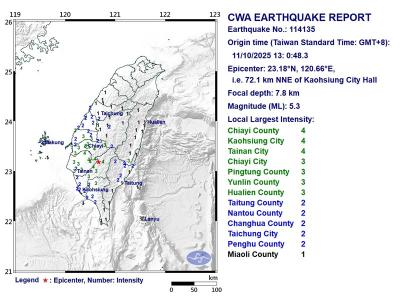Action Coalition of Civics Teachers spokesman Huang I-chung (黃益中) said the Ministry of Education’s changes to high-school curriculum guidelines allowed it to sneak in the desiccated corpse of party-state education of bygone days.
The dogma of the past might be making a comeback in some parts of new high-school civic education textbooks after its removal nine years ago, Huang said.
Changes in 2012 required textbooks to “define the concept of national identification and describe how Taiwanese hold different views on the issue of national identification in accordance with the Constitution,” which allowed textbooks to be more in tune with contemporary matters, Huang said, adding that there were differing ideas on national identification due to internal politico-historical factors and the China factor.

Photo: provided by Huang I-chung
Textbooks introduced the idea that there are many facets of national identification, Huang said, adding that organizations often used identification and political stance as ways to gauge ideas of national identity.
However, the changes that went into effect last month demanded that textbooks follow “the spirit and guidelines behind the founding of the nation as represented in the Constitution,” Huang said.
Such demands will inevitably return textbooks to decades past, when everything was tied into the “three principles of the people,” he said.
“The three principles of the people forms the basis of the Republic of China to be a democratic republic of the people, by the people and for the people,” Huang said, quoting the first article of the Constitution.
Huang said some textbooks have already done so and removed materials that portray “divided views on national identity.”
Democratic Progressive Party (DPP) Legislator Cheng Li-chun (鄭麗君) said the nation was not truly relieved of party-state-dictated education until the implementation of the curriculum on Sept. 5, 2006.
The Chinese Nationalist Party (KMT) established courses specifically teaching the three principles of the people in high schools and vocational high schools since its relocation to Taiwan in 1949, Cheng said.
The implementation and exclusion of the three principles from textbooks is a symbolic representation of Taiwanese fighting for the “democratization of history,” Cheng said, adding that the return of the three principles meant a return of party-state meddling in education.
This is the primary reason the changes must be abolished, Cheng said.
Humanist Education Foundation executive director Joanna Feng (馮喬蘭) said the ministry was “raping Taiwanese education with outmoded autocratic curriculum material,” adding that weak efforts by the administration of President Ma Ying-jeou (馬英九) to “brainwash” students would only be met with disgust from young people.
Taichung official Yen Ching-hsiang (顏慶祥) said the new curriculum was anti-democratic in terms of its treatment of national identification.
It is a regression of education that flew completely in the face of social development and public will, the Bureau of Education director said.
National Academy of Educational Research secretary-general Wu Hsiao-hsia (武曉霞) said that while there were changes to portions outlining national identification, the running consensus of the review committee was that new textbooks should portray the founding spirit of the Constitution, adding however that publishers’ ways to describe that would be respected.

The Central Weather Administration (CWA) today issued a sea warning for Typhoon Fung-wong effective from 5:30pm, while local governments canceled school and work for tomorrow. A land warning is expected to be issued tomorrow morning before it is expected to make landfall on Wednesday, the agency said. Taoyuan, and well as Yilan, Hualien and Penghu counties canceled work and school for tomorrow, as well as mountainous district of Taipei and New Taipei City. For updated information on closures, please visit the Directorate-General of Personnel Administration Web site. As of 5pm today, Fung-wong was about 490km south-southwest of Oluanpi (鵝鑾鼻), Taiwan's southernmost point.

Almost a quarter of volunteer soldiers who signed up from 2021 to last year have sought early discharge, the Legislative Yuan’s Budget Center said in a report. The report said that 12,884 of 52,674 people who volunteered in the period had sought an early exit from the military, returning NT$895.96 million (US$28.86 million) to the government. In 2021, there was a 105.34 percent rise in the volunteer recruitment rate, but the number has steadily declined since then, missing recruitment targets, the Chinese-language United Daily News said, citing the report. In 2021, only 521 volunteers dropped out of the military, the report said, citing

A magnitude 5.3 earthquake struck Kaohsiung at 1pm today, the Central Weather Administration said. The epicenter was in Jiasian District (甲仙), 72.1km north-northeast of Kaohsiung City Hall, at a depth of 7.8km, agency data showed. There were no immediate reports of damage. The earthquake's intensity, which gauges the actual effects of a temblor, was highest in Kaohsiung and Tainan, where it measured a 4 on Taiwan's seven-tier intensity scale. It also measured a 3 in parts of Chiayi City, as well as Pingtung, Yunlin and Hualien counties, data showed.

Nearly 5 million people have signed up to receive the government’s NT$10,000 (US$322) universal cash handout since registration opened on Wednesday last week, with deposits expected to begin tomorrow, the Ministry of Finance said yesterday. After a staggered sign-up last week — based on the final digit of the applicant’s national ID or Alien Resident Certificate number — online registration is open to all eligible Taiwanese nationals, foreign permanent residents and spouses of Taiwanese nationals. Banks are expected to start issuing deposits from 6pm today, the ministry said. Those who completed registration by yesterday are expected to receive their NT$10,000 tomorrow, National Treasury